Tree Branching: What is Opposite Branching?
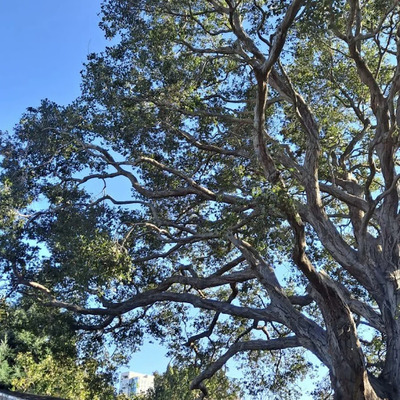
Understanding Tree Branching Patterns: Opposite vs. Alternate Branching
Trees, in their silent grace, present an intriguing array of branching patterns that hold keys to their identity and role in the natural world. Two primary patterns, opposite and alternate branching, denote distinctive aspects of a tree's structure and behavior.
Let's embark on a journey into this botanical puzzle, exploring the differences, ecological significance, and the underlying mechanisms behind opposite and alternate branching. By deciphering these patterns, we unlock a deeper understanding of trees and their ecological relationships and have a better chance at identifying the issues they might be encountering.
Through this exploration, we'll identify species that distinctly showcase each branching pattern, understand the cellular mechanisms orchestrating these patterns, and examine their implications for light distribution, stability, and adaptability.
This journey promises to unveil not just the science behind branching patterns but their real-world impact on ecosystems, tree identification, and resilience in the face of environmental challenges.
So, let's delve into this fascinating world where biology meets pragmatism, where every branch is a clue, and each pattern tells a story of adaptation and survival.
Opposite vs. Alternate Branching: Identifying Characteristics
Opposite Branching
Opposite branching involves side branches growing directly opposite each other along tree limbs, found in select tree species. There are significantly fewer types of trees that have opposite branching in comparison to alternate branching, making identification of trees with this branching pattern simpler. These trees may feature simple leaves, either toothed or smooth, or compound leaves, offering distinct characteristics for identification.
Alternate Branching
Contrary to opposite branching, alternate branching features side branches staggered along tree limbs, alternating back and forth. This pattern is prevalent among the majority of tree species.
Clear Examples of Opposite and Alternate Branching
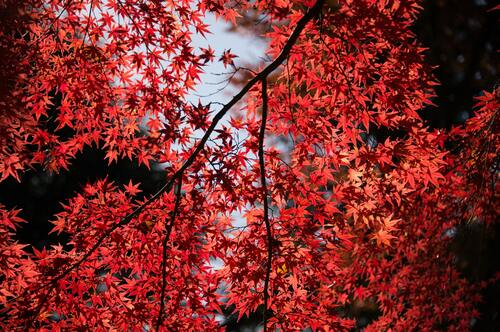
A Tree Branch Covered in Autumn Foliage
Opposite Branching Examples
Here are the only trees that you will ever come across with opposite branching. As we said, there are very few, so they will be much, much easier to identify.
- Dogwood Trees (Cornus spp.): Recognizable for their vibrant springtime blooms, dogwood trees exhibit a clear opposite branching pattern, with branches growing directly opposite each other along the stem. They bear non-edible but visually striking berries—typically red, white, or blue—and hold significance as the state flower of Virginia and North Carolina, and the state tree of Missouri.
- Ash Trees (Fraxinus spp.): Around 65 species of ash trees display opposite branching, characterized by compound leaflets arranged opposite each other along the stem. Belonging to the lilac and olive family, they are identifiable by their compound leaflets comprising 5 to 9 per leaf.
- Maple Trees (Acer spp.): A diverse category comprising over 100 species, maple trees exhibit opposite branching and are predominantly native to Asia. They are widely popular in many countries and are the broadest category of opposite branching.
- Horse Chestnut Trees (Aesculus spp.): These trees showcase opposite branching, contributing to their distinctive foliage and branching structure.
- Other Species: Various plants and shrubs like winter creepers, privets, burning bushes, and those from the Caprifoliaceae (honeysuckle) family also demonstrate opposite branching.
Alternate Branching Examples
Every tree not mentioned in the section on opposite branching falls in the alternate branching category. The following are just a few common examples among the vast number of species within the alternate branching domain:
- Cottonwood Trees (Populus deltoides): Cottonwoods, known for their rapid growth and expansive canopies, showcase a clear alternate branching pattern. These deciduous trees often grow in riparian areas and are characterized by their triangular or diamond-shaped leaves and the distinct sound created by their rustling leaves in the wind.
- Cherry Trees (Prunus spp.): Many cherry tree species display alternate branching, with branches staggered along the stem, allowing for a more open canopy structure.
- Oak Trees (Quercus spp.): Oaks predominantly exhibit alternate branching, contributing to their characteristic sprawling growth patterns.
- Maple Trees (again): While most species of maples exhibit opposite branching, there are exceptions like the Silver Maple (Acer saccharinum) and Sycamore Maple (Acer pseudoplatanus) that demonstrate alternate branching. These exceptions challenge the general rule and highlight the variability within the maple genus.
Environmental Influence
Interestingly, environmental factors such as light availability and competition can influence branching patterns. In some cases, a tree species might exhibit varying branching patterns based on its habitat or growth conditions. This variability underscores the adaptability of trees in response to their surroundings.
Cellular Basis of Opposite and Alternate Branching
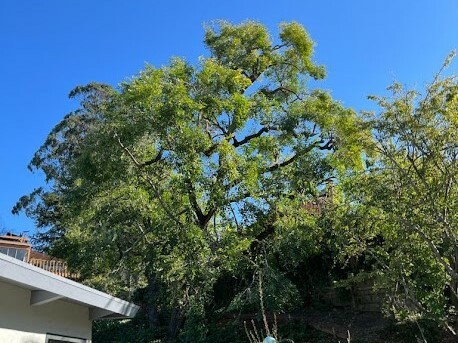
A Tall Tree with Large Branches Next to a House
Tree branching patterns, whether opposite or alternate, stem from a combination of genetic predispositions, hormonal signals, and environmental cues. At the cellular level, auxin's symmetrical or asymmetrical distribution dictates the arrangement of buds and subsequent branch growth, defining these distinct patterns.
Role of Auxin Distribution
Auxin, a crucial plant hormone, plays a pivotal role in determining branching patterns. In opposite branching, auxin is distributed evenly, leading to the development of buds in pairs on either side of the stem. This symmetrical distribution results in branches growing directly opposite each other.
Conversely, in trees with alternate branching, auxin distribution is asymmetrical. Uneven distribution promotes the formation of buds in a staggered pattern along the stem. These buds then develop into branches that alternate on either side, creating the characteristic alternating pattern.
Genetic Regulation
Genetic factors also influence branching patterns. Specific genes control the distribution and response to auxin, dictating the arrangement of branches. For instance, certain genetic mutations can disrupt auxin signaling pathways, altering the regular branching pattern observed in a species.
Environmental Factors
Environmental stimuli, such as light exposure and mechanical stress, can further modulate branching. Light influences auxin transport, impacting branch growth and orientation. Additionally, mechanical stimuli, like wind or physical barriers, may induce changes in branching patterns as trees adapt to external forces.
Canopy Structure and Light Capture Efficiency
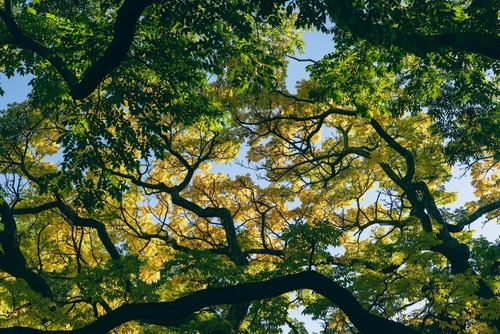
A Tree Canopy as Seen From Below
Opposite Branching: Shading and Canopy Density
Trees with opposite branching patterns often experience higher levels of shading within their canopies. The symmetrical arrangement of branches leads to a denser, overlapping canopy structure. This density results in increased shading between opposite branches, limiting the penetration of sunlight to lower branches and the interior of the canopy.
Alternate Branching: Enhanced Light Distribution
Contrastingly, trees with alternate branching patterns exhibit a more open canopy structure. The staggered arrangement of branches reduces overlap and creates spaces between branches. This configuration facilitates improved light penetration throughout the canopy, allowing for a more even distribution of sunlight to lower branches and the tree's interior.
Quantifying Differences in Canopy Density
Leaf Area Index (LAI)
Leaf Area Index, a measure of the amount of leaf surface area per unit ground area, provides insights into canopy density. Trees with opposite branching tend to have higher LAI values due to their denser canopies, resulting in a higher concentration of leaves in a given area.
Conversely, trees with alternate branching typically have lower LAI values, indicative of a more open canopy structure with less leaf surface area per unit ground area. This arrangement facilitates better light penetration and distribution within the canopy.
Light Penetration and Photosynthetic Activity
Studies have shown that the distribution of light within tree canopies significantly influences photosynthetic activity. Canopies with higher density, characteristic of opposite branching, exhibit reduced light penetration to lower foliage, potentially limiting photosynthetic efficiency in those areas.
Alternatively, trees with a more open canopy, as seen in alternate branching, allow for better light penetration, enhancing photosynthetic activity across various levels of the canopy.
Implications and Adaptations
Ecological Significance
Opposite branching, with its denser canopy, may provide advantages in creating shade and conserving moisture in certain environments. However, it can limit light availability to lower branches and the understory, affecting plant growth beneath the tree.
Alternate branching, by contrast, maximizes light penetration, potentially benefiting understory vegetation and facilitating a more diverse ecosystem by allowing sunlight to reach the forest floor.
Adaptive Strategies
Trees exhibit branching patterns based on evolutionary adaptations to their environment. Opposite branching may be advantageous in competitive environments where shading and moisture conservation are critical. Conversely, trees with alternate branching may thrive in environments where maximizing light capture is more advantageous for growth and survival.
Mechanical Stability and Branching Patterns
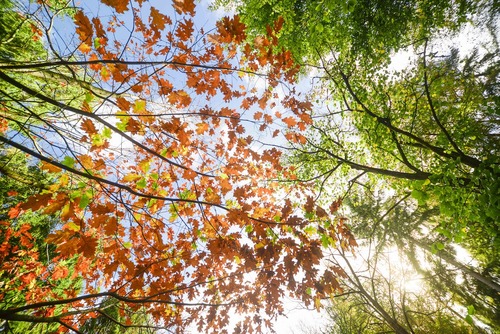
A Diverse, Colorful Tree Canopy
Opposite Branching: Strength and Stability
Trees with opposite branching patterns often exhibit increased mechanical stability against wind or storms. The symmetrical arrangement of branches results in a more rigid structure, offering inherent strength and resistance to external forces. The branches growing directly opposite each other create a balanced, sturdy framework that reduces the risk of breakage during strong winds.
Strength Attributes
Opposite branching patterns provide trees with greater resistance to torsional and bending forces. The symmetrical distribution of branches minimizes the stress concentration points along the trunk, enhancing the tree's overall structural integrity.
Alternate Branching: Flexibility and Vulnerability
In contrast, trees with alternate branching patterns may possess a more flexible structure. The staggered arrangement of branches creates a less rigid framework, potentially allowing for more movement during wind events. While this flexibility can absorb some force and reduce the risk of immediate breakage, it might also increase susceptibility to structural damage in severe storms.
Flexibility Attributes
Alternate branching patterns may provide trees with the ability to bend and sway in the wind, dissipating some of the force exerted on the tree. However, excessive movement can lead to greater stress on individual branches or the trunk, potentially increasing the risk of breakage or damage over time.
Contrasting Strength and Flexibility
Opposite Branching: Strength Over Flexibility
Opposite branching emphasizes strength and stability, minimizing the risk of immediate breakage during strong winds or storms. The rigid structure and balanced arrangement of branches distribute force evenly, reducing vulnerability to wind-induced damage.
Alternate Branching: Flexibility with Trade-offs
Trees with alternate branching patterns prioritize flexibility to some extent, allowing for movement in response to wind. While this flexibility may reduce the risk of immediate breakage, it might lead to increased vulnerability to damage or breakage in severe weather conditions due to the less rigid structure.
Adaptations and Environmental Factors
The choice between opposite and alternate branching patterns often reflects evolutionary adaptations to environmental conditions. Trees in windy or storm-prone areas may favor opposite branching for enhanced mechanical stability. Conversely, trees in less turbulent environments might benefit from the flexibility of alternate branching.
Conclusion
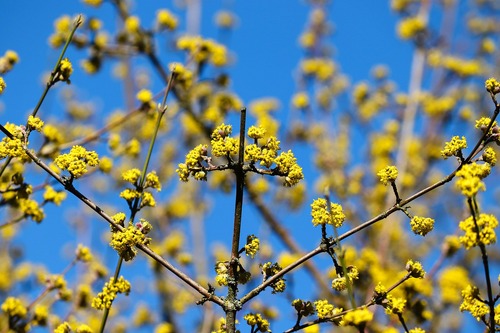
Small Tree Branches with Yellow Flowers
Understanding tree branching patterns isn't just an academic pursuit—it's a practical tool that offers valuable insights into our natural surroundings. It goes beyond identifying tree species; it's about grasping how trees adapt, thrive, and contribute to the ecosystems they inhabit.
By decoding these branching blueprints, we gain a practical edge in managing our environment. Recognizing these patterns aids in accurate tree identification, essential for efficient forestry practices, urban planning, and conservation efforts. For assistance with identifying and managing the trees on your property, contact Arborist Now. Our skilled team members can provide you with personalized information on how to care for your trees!
Originally posted on October 18, 2018





